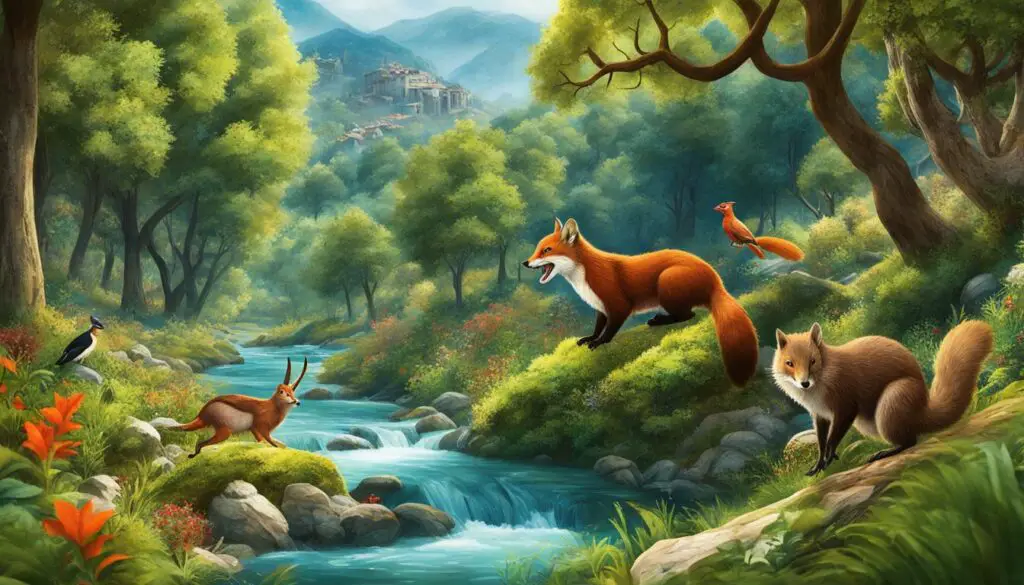Italy is a country renowned for its breathtaking landscapes, rich cultural heritage, and mouth-watering cuisine. But did you know that it is also home to a remarkable array of animals? From the majestic Alps to the stunning Mediterranean coast, Italy’s varied geography and favorable climate create an ideal habitat for a diverse range of wildlife.
The Italian fauna is incredibly vast, with over 57,000 recorded species, making up more than a third of all European fauna. This impressive number puts Italy among the top countries in Europe in terms of biodiversity. The diverse animal kingdom in Italy includes 119 mammal species, 550 bird species, 69 reptile species, 39 amphibian species, 623 fish species, and over 56,000 invertebrate species.

Key Takeaways:
- Italy boasts one of the highest levels of faunal biodiversity in Europe.
- The country is home to numerous endemic species.
- Italian wildlife includes a wide variety of mammals, birds, reptiles, amphibians, fish, and invertebrates.
- Conservation efforts are crucial for protecting endangered species in Italy.
- Italy’s unique geography and diverse habitats contribute to its rich wildlife.
Italian Animal Habitats: From the Alps to the Mediterranean Coast
Italy’s diverse geography provides a range of habitats for its animal species. The country is home to the stunning Alps in the north, which contain alpine meadows and forests that support species like the Alpine marmot and Eurasian lynx.
The central regions of Italy feature the Apennine Mountains, characterized by temperate forests and grasslands, where animals such as the Marsican brown bear and Italian crested newt can be found.
The southern regions of Italy offer a Mediterranean climate, with coastal areas rich in marine life and islands like Sicily and Sardinia that have unique wildlife including the Italian wall lizard and Corsican red deer.
Italian Animal Habitats
| Habitat | Example Species |
|---|---|
| Alpine meadows and forests | Alpine marmot, Eurasian lynx |
| Temperate forests and grasslands | Marsican brown bear, Italian crested newt |
| Mediterranean coastal areas | Italian wall lizard, Corsican red deer |
Biodiversity in Italy: A Haven for Endemic Species
Italy is renowned for its exceptional biodiversity and serves as a sanctuary for numerous endemic species. With an impressive total of 4,777 animal species found exclusively within its borders, the country stands as a testament to the rich variety of life that thrives in its unique ecosystems.
Among the notable endemic species in Italy are the fascinating Sardinian long-eared bat, the iconic spectacled salamander, the elusive Italian frog, and the charming Sicilian pond turtle. These creatures have adapted to the specific environmental conditions found in Italy, making them truly unique and significant from a conservation standpoint.
The exceptional biodiversity of Italy can be attributed, in part, to its strategic location as a natural corridor between central Europe and North Africa. This geographical advantage allows for the convergence of different species, resulting in the emergence of distinct and endemic wildlife.
Italy’s diverse landscape, encompassing awe-inspiring formations such as the Alps, Apennines, and coastal areas, provides a range of habitats that support the flourishing of endemic species. These natural environments, teeming with life, are vital for the survival and preservation of Italy’s unique fauna.
To protect the treasured endemic species of Italy, dedicated efforts have been made in the form of establishing animal sanctuaries and implementing conservation programs. These initiatives are specifically designed to safeguard critically endangered species like the majestic Marsican brown bear and the charming Apennine yellow-bellied toad. By creating safe havens and promoting responsible conservation practices, these sanctuaries are playing a crucial role in preserving Italy’s remarkable fauna.

Italian Biodiversity in Numbers:
| Category | Number of Species |
|---|---|
| Mammals | 119 |
| Birds | 550 |
| Reptiles | 69 |
| Amphibians | 39 |
| Fish | 623 |
| Invertebrates | 56,000+ |
Italy’s rich and vibrant biodiversity exerts a significant influence on both the natural environment and the cultural heritage of the country. By recognizing the importance of endemic species and prioritizing their conservation, Italy is ensuring the preservation of its unique wildlife for future generations to enjoy.
The Challenges of Wildlife Conservation in Italy
Italy’s rich biodiversity and diverse animal population are facing various challenges when it comes to wildlife conservation. The preservation of Italian wildlife is crucial due to the threats posed by habitat loss, pollution, and climate change. These factors endanger the survival of numerous animal species and highlight the urgent need for focused conservation efforts.
Endangered species in Italy, such as the Marsican brown bear and Apennine yellow-bellied toad, require immediate attention and conservation measures to ensure their long-term survival. The decline in suitable habitats and the degradation of ecosystems put these species at risk. The Italian government and various organizations have taken steps to protect these endangered species by implementing habitat restoration programs and establishing captive breeding initiatives.
Educating the public and increasing awareness about the importance of wildlife conservation are essential tools in safeguarding Italy’s precious fauna. Public awareness campaigns play a vital role in promoting responsible human interactions with wildlife and encouraging sustainable practices. By empowering individuals with knowledge and fostering a sense of stewardship, we can collectively work towards preserving Italian wildlife for future generations.
Habitat Loss:
The destruction and fragmentation of natural habitats pose a significant threat to Italian animal species. Human activities such as deforestation, urbanization, and agriculture lead to the loss of crucial habitats for many wildlife populations. Consequently, these animals face displacement, decreased access to food and water sources, and increased vulnerability to predators.
Pollution:
Pollution in Italy’s air, water bodies, and soil negatively impacts the health and survival of animal species. Industrial pollution, chemical runoff from agriculture, and improper waste disposal harm not only aquatic species but also those dependent on contaminated resources. The accumulation of pollutants in the food chain further compromises the well-being of wildlife populations.
Climate Change:
The escalating effects of climate change, including rising temperatures, altered precipitation patterns, and extreme weather events, pose significant challenges for Italian wildlife. These changes disrupt ecosystems and impact breeding patterns, migration routes, and food availability, ultimately leading to population declines and increased vulnerability to disease.
“The preservation of Italian wildlife is a collective responsibility that requires immediate action to address the challenges of habitat loss, pollution, and climate change.”
Despite these challenges, various organizations and individuals are actively involved in wildlife conservation in Italy. Through collaboration and partnerships, conservation programs aimed at protecting endangered species and their habitats have been established. The combined efforts of the government, conservation organizations, researchers, and local communities are essential in mitigating the threats faced by Italian fauna.
| Challenges | Impact on Wildlife |
|---|---|
| Habitat Loss | Displacement, decreased access to resources, increased vulnerability |
| Pollution | Health issues, decreased reproductive success, disruption of ecosystems |
| Climate Change | Population decline, altered breeding patterns, increased susceptibility to disease |
The preservation of Italian wildlife requires a multi-faceted approach involving habitat restoration, captive breeding programs, and the implementation of sustainable practices. It is vital to engage local communities, raise awareness among the public, and promote responsible interactions with wildlife. By safeguarding the endangered species and protecting their habitats, we can ensure the continued existence and thriving of Italy’s unique fauna for generations to come.
Protecting Italian Wildlife: Conservation Initiatives and Partnerships
The conservation of Italian wildlife is a collaborative effort that involves various organizations, government agencies, and local communities. Conservation initiatives in Italy focus on preserving both individual species and their habitats. Some notable programs include:
- The Conservation of the Marsican Brown Bear in the Parco Nazionale d’Abruzzo, Lazio e Molise: This project aims to protect and restore the habitat of the critically endangered Marsican brown bear. The park provides a safe haven for these bears and implements measures to minimize human-wildlife conflicts.
- The Protection of Marine Biodiversity through the Establishment of Marine Protected Areas: Italy has established numerous marine protected areas along its coastline, which serve as important sanctuaries for marine species. These areas are regulated to minimize human activities that may harm the marine ecosystem.
- The Reintroduction of Endangered Species such as the Sardinian Deer: Efforts are underway to reintroduce the Sardinian deer, a species once believed to be extinct in the wild. These initiatives involve captive breeding programs and habitat restoration to support the survival and growth of the population.
Local communities and volunteers play a vital role in monitoring and protecting the country’s wildlife. Their involvement includes conducting research, participating in conservation projects, and raising awareness among the public about the importance of Italian fauna conservation. By fostering partnerships between different stakeholders, Italy continues to make significant strides in safeguarding its unique wildlife.
Conservation Initiatives and Partnerships in Italy:
| Organization | Focus | Projects |
|---|---|---|
| World Wildlife Fund (WWF) Italy | Overall conservation | Protection of endangered species, habitat restoration, sustainable land use |
| Italian Society for the Protection of Birds (LIPU) | Bird conservation | Monitoring and protection of bird species, habitat conservation |
| Italian National Agency for Parks (Parks Italy) | Protected areas management | Maintenance and preservation of national parks, ecosystem restoration |
| Italian Federation for the Environment and Nature Conservation (FAI) | Cultural and environmental heritage preservation | Restoration and maintenance of natural and historical sites |
These organizations collaborate with government agencies, universities, and local communities to implement effective conservation strategies. Together, they work towards ensuring the long-term survival and thriving of Italy’s unique wildlife.

Conclusion
Italy’s diverse and abundant wildlife is a testament to the country’s unique geography and rich biodiversity. From the majestic Alps to the beautiful Mediterranean coast, Italy offers a range of habitats that support a wide array of animal species. The Italian fauna includes 119 mammal species, 550 bird species, 69 reptile species, 39 amphibian species, 623 fish species, and over 56,000 invertebrate species.
While conservation efforts face challenges, ongoing initiatives and partnerships are working towards protecting and preserving Italy’s precious fauna. Conservation programs focus on preserving both individual species and their habitats. By raising awareness, implementing conservation programs, and engaging local communities, there is hope for the continued survival and thriving of Italy’s unique wildlife.
Efforts have been made to protect Italy’s endemic species, such as the Sardinian long-eared bat, Sicilian pond turtle, and Apennine yellow-bellied toad. The establishment of animal sanctuaries and conservation programs have played a significant role in safeguarding these rare and unique creatures. Additionally, measures are being taken to protect endangered species, like the Marsican brown bear and Apennine yellow-bellied toad, through habitat restoration and captive breeding programs.
Conservation of Italian wildlife is a collaborative effort involving various organizations, government agencies, and local communities. Conservation initiatives focus not only on preserving species but also on their habitats. By working together, there’s a collective effort to ensure the continued survival and thriving of Italy’s precious fauna.
FAQ
What is the biodiversity like in Italy?
Italy boasts one of the highest levels of faunal biodiversity in Europe, with over 57,000 recorded species representing more than a third of all European fauna.
What are some of the notable animal species in Italy?
Italian wildlife includes 119 mammal species, 550 bird species, 69 reptile species, 39 amphibian species, 623 fish species, and over 56,000 invertebrate species. Prominent species include the Italian wolf, Sardinian long-eared bat, Sicilian pond turtle, and Apennine yellow-bellied toad.
What habitats can be found in Italy?
Italy’s diverse landscape provides a range of habitats, including the Alps in the north with alpine meadows and forests, the Apennine Mountains in the central regions with temperate forests and grasslands, and the southern regions with a Mediterranean climate and rich marine life along the coastal areas and islands.
How does Italy protect its unique wildlife?
Italy has established animal sanctuaries and conservation programs focused on preserving endangered species, such as the Marsican brown bear and Apennine yellow-bellied toad. Efforts also include habitat restoration, captive breeding programs, and public awareness campaigns.
Who is involved in wildlife conservation in Italy?
Conservation initiatives in Italy involve various organizations, government agencies, and local communities. Notable programs include the conservation of the Marsican brown bear, the protection of marine biodiversity through marine protected areas, and the reintroduction of endangered species like the Sardinian deer.
